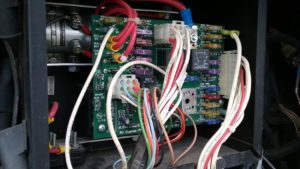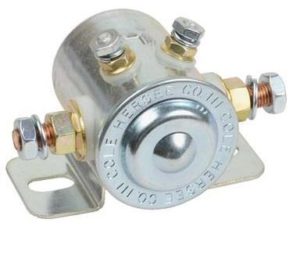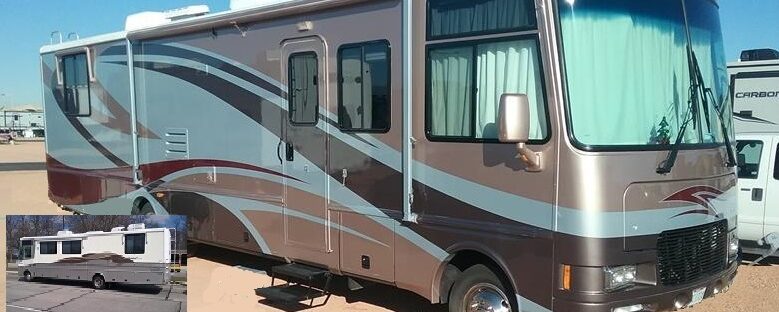A little history first to explain the problem.
When we first bought the Southwind, the previous owner said he had a problem with the chassis battery going dead. A couple months later, I went to start it, nothing, dead. I pressed the EMER START button, nothing. I did a quick check with a voltmeter and the chassis battery showed something like 7 volts. HUM, the battery was 5 years old, the previous owner mentioned a couple problems, its probably a bad cell. I bought a new battery and all was well.
QUESTION – Why didn’t the isolator solenoid pull in when I pressed the EMER START button?? Although I asked this question, I never investigated to find the answer, more on this later.
I ordered a Trik-L-Start charge module to keep the chassis battery charged when its plugged in. Again, ignorance on my part. The Southwind’s BCC should keep the chassis battery charged when its on shore power.
A couple days ago, I was working on something inside and needed to start the engine. it did the exact same thing: Nothing, dead, no instrument lights, nada, zip…. I started the Southwind a week ago, so the battery should NOT have died in that short period of time. I pressed the EMER START button, nothing, no click, no nothing. OK, Time to figure out whats going on.
I pressed the battery disconnect switches, I heard both solenoids disconnect. I then press the CONNECT switches, both solenoids click. This sounds normal.
I checked the voltage at the batteries, chassis = 0 (zero) , coach = 13.3. I’m plugged into shore power so the converter is supplying the 13.3 volts and keeping a slight charge on the coach batteries.
I removed the cover from the BCC and measured the voltage on both sides of the isolator solenoid, voltages on the solenoid were the same as the batteries, chassis = 0 (zero) , coach = 13.2.. I noticed the solenoid was hot, so I figured it had been energized for a while. I checked the voltage at the coil terminal and I seen 12.5 volts. The solenoid is energized. To verify, I remove the coil wire, CLICK, I hear it de-energize. I re-connect the coil wire, CLICK, it re-energizes. I then check the voltage on the battery terminals, no change, chassis = 0 and the coach = 13.2.
CONCLUSION – The Solenoid is obviously bad, Even though the coil is energized with a distinct CLUNK, the internal contacts are not being made.
QUESTION: Why is the solenoid staying energized? This is why I didn’t hear it CLUNK when I pressed the EMER START switch, because it was already energized.
ANSWER: This is normal. I did a lot of hunting and research on the BCC to find out exactly how it works. I have a RV Custom Products circuit board, P/N CB-115 REV B. This BCC energizes the isolator solenoid when it sees either the coach or the chassis battery above 13.2 volts. This allows the the coach to charge the chassis and vice -versa. I don’t need the Trik-L-Start module after all.
QUESTION: Why did the Chassis battery go dead in just a couple days
ANSWER: I think I had the radio turned on, but the volume was low. The radio gets powered from the chassis battery anytime its turned on, so it could have run the battery down in a few days.
REPLACING THE SOLENOID
The solenoid is a continuous duty 12 volt solenoid, Cole Hersee #24213. these are a little pricey, but available everywhere.
I remove the cables from the chassis and the coach batteries. I also unplugged the shore power connection to make sure there wasn’t any power applied to the Southwind.
 The Solenoid is tucked away behind the BCC circuit board. I took several photos so I knew where to reconnect the internal connectors.
The Solenoid is tucked away behind the BCC circuit board. I took several photos so I knew where to reconnect the internal connectors.
I removed the board and the old isolator solenoid. The mount holes in the new solenoid don’t line up with the old solenoid. I connected the battery buss bars to the solenoid, then marked where the mount holes needed to be. I then drilled pilot holes and was able to re-use the old sheet metal screws in the new pilot holes to mount the solenoid.

I reconnected everything, double checking the connections to make sure everything is re-connected properly.
The batteries were reconnected, and voltage readings confirmed that the isolator was working properly. The EMER START switch also worked correctly to energize the solenoid.

I’m Boondockin on iRV2… Awesome website awesome resource… thank you for doing this… I’m having the same issue on our 2000 Georgie Boy Cruise Master… it’s on a 1999 F53 Chassis… it’s on my list to fix… just haven’t gotten around to it… the emergency start worked when I got it… now it just clicks and won’t boost the engine… plus the engine battery is not getting charged while on shore power… I bought a battery tender in the interim… need to get this taken care of… plus I need to upgrade the charger/ converter while i’m at it… thanks again…
Solenoid at advanced auto for $40. Continuous duty 12
If its clicking the solenoid is energizing, but the contacts aren’t engaging. Thats exactly what mine was doing.
Hi. Your www is a gold mine! Thanks for all the knowledge and sharing.
Question. Should chassis battery be charged when connected to the shore power? Or is it only that house batteries are being kept in good condition while stationery and connected? If shore power is not charging starter battery, what’s the easiest way to change it? Long periods without starting the engine could drain starter battery quite easy… Tnx.
Where did you get the solenoid? What is the part #?
I have a 32ft ’99 Southwind and am having the same issue.
Thanks you for all your hard work on this site. I have found it a great resource.
I got mine at West Marina. You should be able to get at almost any auto parts store, but you need to be careful. You want a continuous duty battery idolator solenoid, not a starter solenoid.
Thanks for posting this. What amp solenoid did you use?
Thanks for another great article! On my 1999 Pace Arrow Vision, I ran into a similar problem. I was able to replace the solenoid without removing the circuit board. I just detatched the wires from the solenoid terminals, removed the mounting screw and pulled the post on the lower “bar”, to allow the solenoid to drop out of place. Replacement was pretty straightforward. I used an 85amp Cole Hersee continuous duty solenoid.
Just had the same issue on my 1994 Storm. I used a 300a continuous solenoid https://www.amazon.com/gp/product/B072MZHK48/ref=ppx_yo_dt_b_asin_title_o05_s00?ie=UTF8&psc=1
Stupid Question: where is the BCC? I have a 99 south wind also.
On mine, under the hood. its a big black box on the drivers side, just below the brake master cylinder
My switches don’t click to shut off batteries. Is there a fuse going to selanoid that might need to be replaced or do I need to replace solenoid?I just put new batteries all
Around our 2005 Southwind I ended up disconnecting my wire to house batteries from main to not draw power till I figure out.
On mine, the switches are a momentary contact type with the center position being OFF.
When I click them, either CONNECT or DISCONNECT, I can hear a distinct KLUNK coming from my BCC as the solenoid pulls the magnet contacts in or out.
New house batteries, yet the dash meter reads low battery
and no 12v house items will run not even LP gas relay.
My 2 batteries (12v AGM), are new and checked out full charge
on my hand held meter.
Why isn’t my RV coach (1999 Bounder 32FH) detecting full batteries?
My genny won’t turn over either.
Shore power’s running good and the RV starts and runs great,
but new house battery’s power is being detected as low.
My DC aux/main off/on switches operate great too.
Anyone know why my RV is detecting house batteries as low
when they’re 100% charged?
Thx!
Was this problem ever solved? I have a similar situation and it has me stumped. 2015 Fleetwood Southwind 36L with the F73-1020 BCC. Lithium house batteries are fully charged and measure proper voltage. Aux voltage shown on the monitor panel reads low (9.5 – 10.5 volts). Fridge says lo DC. I measured the DC voltage going from the BCC to the fuse block and it is also low. Coach Battery input to BCC box is good. Matches battery voltage. Coach battery output from BCC is low. Toggling the isolation relay brings voltage up to Chassis voltage level but it drops back down when the relay drops out. All circuit breakers and fuses are fine. Tried isolating the DC loads but nothing seems to be dragging the voltage down. Disconnects appear to work fine.
There are two circuit breakers in the bottom left side of the BCC, verify these aren’t popped.
Listen carefully when you toggle the AUX connect and disconnect switches to verify the solenoids are latching. i.e. Press and hold the AUX CONNECT, you should hear a klunk. Now, listen carefully as you release the switch, you should NOT hear a klunk.
Do the same thing fr the DISCONNECT part, press and hold, you should hear a klunk. when you release the switch you shouldn’t hear anything.
Yes there is. It is F 19 on the F73 1020 BCC
I have a 2017 Fleetwood Bounder. I was having the same issue where no voltage was going to the chassis batteries. No steps, no slides, so cameras and no windshield wipers. I am pretty certain it is the solenoid not working properly. I turned the ignition on, but did not engage the starter, then pushed the auxiliary Starter switch. I heard the solenoid click and now everything works again. I think one of the issues was having to replace all 4 batteries on the coach.
Hello,
I too have the 1999 Southwind 35S, early 2 valve/cyl V10.
Have a similar issue with the battery isolator solenoid. First time I’ve seen this and the same result as yours, a low chassis battery which is not being charged when plugged in to shore power. My solenoid is also energized on, but without outputting a charge to the chassis battery. I am wondering if the act of keeping the solenoid itself energized causes enough draw on the chassis battery to deplete it over a few days, as opposed to radio, propane detector etc drawing it down. Any thoughts? Thanks for your fantastic website……. It’s been a lifesaver on more than one occasion. Cheers!
Yes it will. The solenoid draws a lot of current.
One other question, is that the ColeHersee 24213?
Trying to sort out what amperage solenoid is needed. Thanks
I’m not sure. The most important item is it must be a continuous duty solenoid.
Ok thanks. Just picked up a pico 85amp unit.
I have a 2004 fleetwood storm I am having problems with my house battery’s going dead over night all battery’s new and my switches for six and main will not turn off ?
Does your Storm have a BCC similar to my Southwind? If so, there is a fuse in the BCC for the connect/disconnect switches. I believe its F19 and may be labeled BD FUSE.
I have a 1999 pace arrow, my chassis battery is not getting a charge from shore power, IT is new, all my relays are new and the BCC is one year old
The aux disconnect sw does nothing It appears all circuit breakers are working I need some ideas please help.
Does the MAIN disconnect/connect work??? You should hear a distinctive CLUNK when pressing the disconnect or connect for either the AUX or MAIN..
Hi,
my house battery and wont charge from alternator. after testing, i find i
do not have much voltage across 2 small terminals on selonoid.
there is a transistor?? at Q2 on the board that seems like it has a loose connection. if i move it slightly i get between 9 and 12 volts across the small terminals on the selonoid and can hear the click. i also notice this transistor?? gets hot. does this sound normal? i can take the board out and solder the transistor connections but i am not sure this should be getting hot.
any thoughts or help would be great.
love all the information you have listed. it is very helpful
i have a 99 pace arrow
the house batterys are not charging when driving. i was checking the solenoid and was curious, what should the voltage be across the two smaller terminals. at first i was only reading less than a volt, but there appears to be a loose diode? transistor?? in Q2 when i wiggle it i can hear a click and the voltage goes tobetween 9 and 12 volt.
i can solder this back in place but i also notice this diode? transistor?? seems to get pretty hot. is this normal? is the voltage norma? should this voltage always be there when the alternator is charging the house batterys?
any info or help is appreciated.
Thanks
See if you can read any numbers off of it before soldering, i.e. 2N3906. get a close up photo of it.
Verify you have the correct solenoid installed, i.e. should be a continuous duty solenoid, not a start solenoid.
I have discovered a couple issues. first was the transistor in Q2 (TIP42C) had a burnt hole in it. I replaced that. I replaced the main seleonoid.
i also replaced all the insulators that go through the metal case holding the stud terminals the wires connect to. and the last issue was one more transistor got bent while working on the connections. the transistor in Q1 position had two legs touching causing the engine to go dead after about a minute or two. i replaced this transistor (2N3904) and all is well now.
I am finally a happy camper 🙂
I have a 2000 Fleetwood Bounder that the coach and chassis batteries would not charge on shore power. The engine would also not start using the aux switch. I replaced the Isolator Battery solenoid and now my coach batteries as well as the aux switch to start the coach are working, but my chassis battery still doesn’t charge on shore power. Any ideas on what I should be looking for? Appreciate any help
Verify that the coach and chassis disconnect solenoids are working.
Also, verify that the idolator solenoid is energizing when on shore power. This solenoid gets energized two ways. 1) anytime you press the EMER button, and 2) anytime the BCC detects the voltage on either battery is above 13.2 volts. If you press that button while on shore power and you hear a thunk, that means that the solenoid was not energized. possible converter voltage is to low (13.2 volts)
I did verify that the coach and chassis battery solenoids are working. The chassis battery is currently dead and when I measured voltage it was at 7 volts DC. I then went to the BCC and measured voltage there and everywhere I checked I got 0 Volts. I discovered a 15 amp fuse missing on I believe F2 labeled ” Spare Chassis BD”. I inserted fuse and then measured voltage at the BCC and got 7 volts. I left it plugged into shore power overnight and will check it today to see if the chassis battery begins charging.
There are two small 12 volt circuit breakers in the lower left corner of the BCC, make sure these aren’t tripped.
So, I checked the 12 volt circuit breakers in the lower left corner and they were not tripped. I did put a charger on the battery as we are planning a weekend camping trip. When I checked voltage on the battery after a day on the charger it was only reading 6 volts. I then tapped on the relays on the BCC Circuit board and noticed my charger jumped to 12 volts. Is it possible that could be the problem and if so do you the part number for that board?
Your readings don’t make sense.. Take a couple photos of exactly where you’re taking voltage measurements. Text them to me at
four one nine seven eight seven ninty five eighty five.
I have a 1999 Southwind. I found a (what looks like a fuse plug with a small spring sticking out fo a, …broken plug.) I cannot find the other end of the plug where I think a fuse goes into.
Do you know where this goes or have a wiring diagram that show a “spring-loaded fude” ?
Thank you/